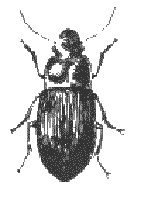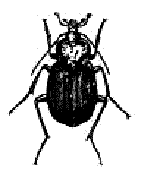Home Page
Meetings:
Minutes (pdf file)
Treasurer's Report (pdf file)
Agenda (pdf file)
Administration:
District Officers
By-laws &
Standing Rules
Protocols
Award Honorees
Conferences
History
Local Societies
Society Update Form
Personal Update Form
Logos
Newsletter (pdf file)
Public Gardens
Consulting Rosarians:
Consulting Rosarians
Annual Report Form
CR Status
Master Rosarian Form (pdf file)
How to become a Consulting Rosarian
Judges:
District Judges
Hort. Judges' Report Form
Arr. Judges' Report Form
Hort. Judge's Status
Arr. Judge's Status
Rose Shows:
District Trophies & Winners
Rose Show Results
Rose Culture:
District Roses in Review
Award of Merit Articles
District Rose Culture
Best Roses for the District
Misc:
Other Interesting Sites
Text Site Map
Award of Merit Winner
by JOLENE ADAMS
NCNH District Director, Judge, Consulting Rosarian
There are a great number of species of ground beetles ( over 40,000!), and some are rather ferocious looking - resulting in some very worried home-owners! These shiny, blackish brown beetles are predators on other garden insects but may enter houses in the spring looking for other insects (food).
Ground beetles have well developed mandibles (big, vicious cutting mouthparts), but are not known to bite people. They use their strong mouthparts to devour other insects. The larval stages of ground beetles are also aggressive predators on insects, but they live below ground in the grass and soil around the house, where they use their large pincher-like mandibles to devour soil-dwelling insects.
The ground beetle is found everywhere - just turn over a log or a brick or a paving stone. See those black "heavily armored" beetles run like crazy??? Zip! Zip! ... and they’re gone. They’re fast, and they get the job done. If you do get a good look at them you’ll see that their head is way smaller than their body and they have short, stringy antennae.
Mainly coming out at night, they try to stay undercover by day - sleeping and staying cool by hiding under low foliage, logs, stones, in dark crevices and cracks. They are not particularly anxious to make friends with you so don’t bother to start a conversation. They are running too fast to talk back.
Female ground beetles lay eggs in the soil. Eggs hatch into larvae that feed in or on the soil under debris (where the other bugs are hiding ... especially earwigs!). They usually only have one generation each year, so if you kill off all the insects in your garden with beetle-killing insecticides, then you are going to be at the mercy of the snails and cater-pillars. The adults over-winter under your mulch or in cool, moist deposits of garden debris.
 The common ground beetle is an important predator insect, aiding in the control of a few particular pests in the field or garden. With all those different species, you know that their menu is varied, but they mostly eat the bugs you don’t like. And ... hang onto your hat now ... this guy also eats snails and slugs!!! He munches the eggs, chomps the little ones, attacks the big ones - they’re all escargot to him. He also eats caterpillars, maggots, and other soft bodied insects.
The common ground beetle is an important predator insect, aiding in the control of a few particular pests in the field or garden. With all those different species, you know that their menu is varied, but they mostly eat the bugs you don’t like. And ... hang onto your hat now ... this guy also eats snails and slugs!!! He munches the eggs, chomps the little ones, attacks the big ones - they’re all escargot to him. He also eats caterpillars, maggots, and other soft bodied insects. When inspecting the yard for insect pests, it helps to know which are the good bugs and which are the bad ones. The good ones help us by naturally keeping under control those pests that cause damage to our trees, shrubs, and other garden plants. By encouraging a population of good bugs to make a home out of your garden - you will use less pesticides and enjoy your garden more.
When inspecting the yard for insect pests, it helps to know which are the good bugs and which are the bad ones. The good ones help us by naturally keeping under control those pests that cause damage to our trees, shrubs, and other garden plants. By encouraging a population of good bugs to make a home out of your garden - you will use less pesticides and enjoy your garden more.
Last updated: 3/7/09
©NCNH District
All Rights Reserved
Webmaster: gailtrimble@ncnhdistrict.org